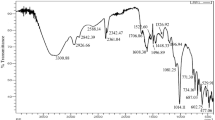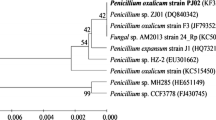Abstract
Theaflavins were synthesized from tea polyphenols extracted from green tea using an immobilized polyphenol oxidase system. To optimize the production of theaflavins, response surface methodology was applied to determine the effects of five critical variables and their mutual interactions on theaflavin biosynthesis at five levels. A total of 52 individual experiments were performed and a statistical model predicted that the highest theaflavin concentration was 0.766 mg ml−1 at optimized conditions. Using these optimal parameters under experimental conditions in three independent replicates, the average value of the biosynthesized theaflavin concentration reached 0.75 ± 0.017 mg ml−1 and matched the value predicted by the model
Similar content being viewed by others
References
DK Ganguly (2003) ArticleTitleTea consumption on oxidation damage and cancer ICMR Bull. 33 37–51
S Gupta B Saha AK Giri (2002) ArticleTitleComparative antimutagenic and anticlastogenic effects of green tea and black tea: a review Mutat. Res. 512 37–65 Occurrence Handle1:CAS:528:DC%2BD38XmvVCrtrc%3D
H Huang XQ Xu (2004) ArticleTitleAnticancer activity of tea: evidence from recent animal experimental and human studies J. Tea Sci. 24 1–11 Occurrence Handle1:CAS:528:DC%2BD2MXmsVCju7s%3D
JR Lewis AL Davis Y Cai AP Davies JPG Wilkins M Pennington (1998) ArticleTitleTheaflavate B, isotheaflavin-3′-O-gallate and neotheaflavin-3-O-gallate: three polyphenolic pigments from black tea Phytochemistry 49 2511–2519 Occurrence Handle1:CAS:528:DyaK1MXjslOrsQ%3D%3D
Li L, Xiao W (2002) Optimization on preparing parameters of tea pigments from tea polyphenols oxidized in bi-liquid phase system. J. Tea Sci. 22: 119--124 (in Chinese).
A Robertson (1983a) ArticleTitleEffect of physical and chemical conditions on the in vitro oxidation of tea leave catechins Phytochemistry 22 889–896 Occurrence Handle1:CAS:528:DyaL2cXjtlCrtw%3D%3D
A Robertson (1983b) ArticleTitleEffect of catechin concentration on the formation of black tea polyphenols during in vitro oxidation Phytochemistry 22 897–903 Occurrence Handle1:CAS:528:DyaL3sXlslCgtr0%3D
S Sang JD Lambert S Tian J Hong Z Hou JH Ryu RE Stark RT Rosen MT Huang CS Yang CT Ho (2004) ArticleTitleEnzymatic synthesis of tea theaflavin derivatives and their anti-inflammatory and cytotoxic activities Bioorg. Med. Chem. 12 459–467 Occurrence Handle1:CAS:528:DC%2BD2cXjsVOrtg%3D%3D
Tu YY, Xia HL (2004) Biosynthesis of high quality theaflavins from purified tea polyphenols using immobilized polyphenol oxidase. China Patent 02136982.8 ZL.
YY Tu AB Tang N Watanabe (2004) ArticleTitleThe theaflavin monomers inhibit the cancer cells growth in vitro Acta Biochim. Biophys. Sin. 36 508–512 Occurrence Handle10.1093/abbs/36.7.508 Occurrence Handle1:CAS:528:DC%2BD2cXptlKgt7o%3D
Author information
Authors and Affiliations
Corresponding author
Additional information
Revisions requested 03 November 2004; Revisions received 7 December 2004
Rights and permissions
About this article
Cite this article
Tu, YY., Xu, XQ., Xia, HL. et al. Optimization of theaflavin biosynthesis from tea polyphenols using an immobilized enzyme system and response surface methodology. Biotechnol Lett 27, 269–274 (2005). https://doi.org/10.1007/s10529-004-8292-4
Received:
Accepted:
Issue Date:
DOI: https://doi.org/10.1007/s10529-004-8292-4




